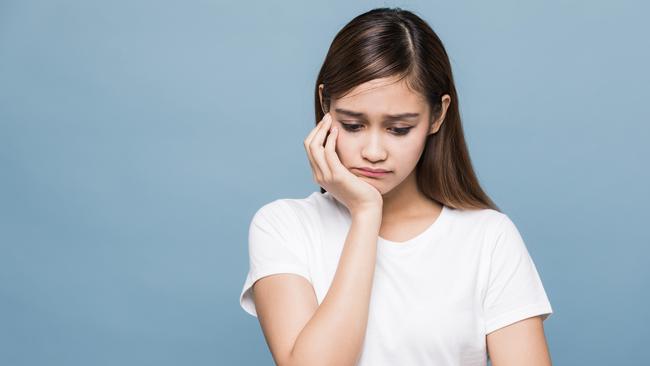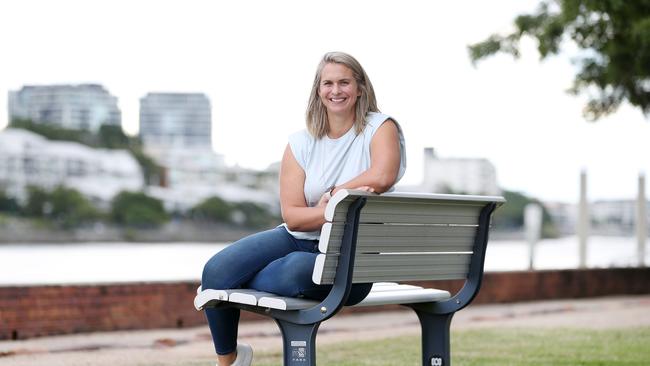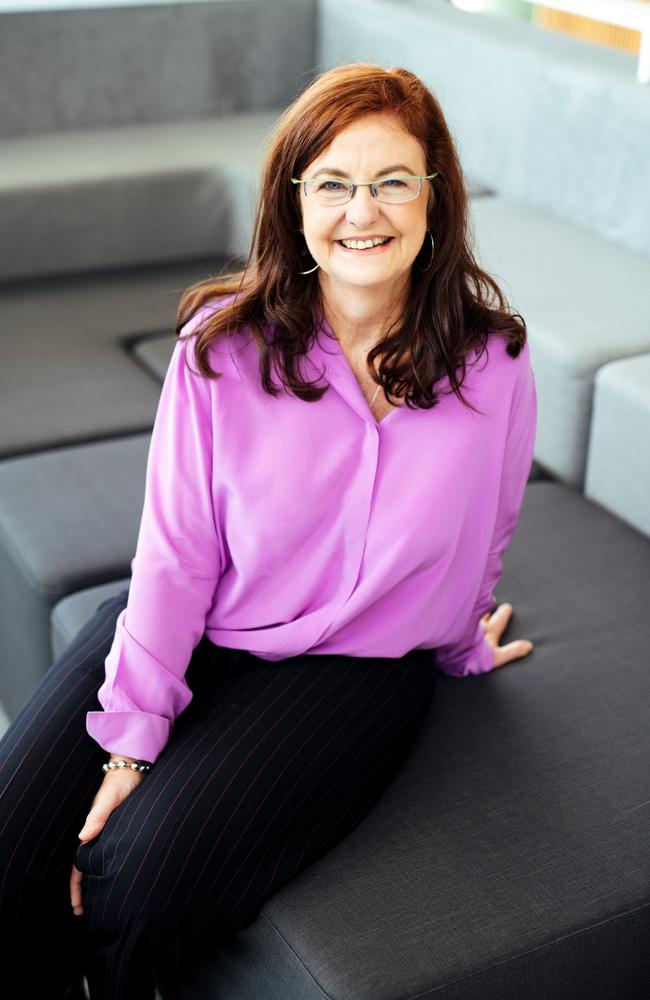‘Slippery slope’: Teachers’ terrifying insights into our girls’ mental health
From severe anxiety to self-harming, our teachers are first-hand witnesses to the insidious and widespread impact of the mental health challenge being faced by their students, particularly girls.

QWeekend
Don't miss out on the headlines from QWeekend. Followed categories will be added to My News.
Imagine 1000 students packed into one room. They’re all 16 and 17 and 18, and you have one question for them: “What’s the biggest challenge you face?”
They all scribble down an answer, and you ask those who nominated a mental health issue to move to one side of the room. Those who wrote those two words “mental health” move first, and then those who nominated anxiety and then eating disorders and then depression and isolation, body image, stress and panic attacks all shuffle to one side. Soon one side of the room is not big enough, and they spill back to where they were. About 700 of them.
That’s how many respondents – about seven in 10 – tagged mental health, or something that broadly fitted that description, when answering that question. Seven out of 10!
While “time management”, “passing maths”, “motivation”, “balancing everything”, “the future” and “external exams” popped up many times, most girls saw their key challenge as relating to how they viewed their mental health.
Answers like: My mental health. Anxiety. My perfectionist tendencies. Body image. Getting up every day and dealing with everything going on. Managing my anxiety and learning to not let my intuitive thoughts overwhelm me and impact my life. Thinking about things too much. Living with depression. Anorexia. Attention deficit disorder. My inner anorexia demons.
Many haven’t been diagnosed, and that means that how they feel doesn’t fit into any neat little box.
“I would say I really struggle with mental health challenges,” one girl explained. “I am not diagnosed with anything like depression or anxiety, which makes me feel really confused and left in the dark because I know that I struggle quite badly but I don’t have any ‘real’ issues that can mess with me.”

Just as telling as the number of girls feelingchallenged by their mental health is the response by health experts. None of them is surprised by those high numbers. Sydney GP Dr Danielle McMullen is the president of the NSW division of the Australian Medical Association (AMA).
“My waiting room is full of everyone struggling with their mental health,” she says.
“And I think at least 80 per cent of my GP consultations across all age groups have a mental health aspect at the moment. So I’d say that doesn’t surprise me.’
In addition to specific diagnosable mental illness, a level of stress has been sitting over the whole community, and the impact of that should not be underestimated, she says. “It can have physical and mental consequences. It can be really debilitating. And whole communities can feel anxious, feel worried, feel stress.”
That can impact teens, who are also feeling the stress around the pandemic and worrying about the climate and their futures. “At the moment, they’re worried about those big issues and the acute stress of financial strain and how to get through the Covid crisis the same way the rest of us are,’ McMullen says.
Outside waiting rooms and inside classrooms, educators see the insidious and widespread impact of the mental health challenge being faced by their students. It keeps Australian Secondary Principals’ Association president Andrew Pierpoint awake at night.
“I think mental health has been on a very, very slippery slope for many, many years … long before we ever knew what the word Covid meant,” he says.
“It’s been fertilised by heavy workloads, how society sees itself, and the pervasive nature of social media. The workload at school now is crazy; it’s absolutely out of control,” he says.
Add teens’ busy schedules, including part-time jobs, and there is no downtime. No balance. In 2021, Brittany Higgins and Grace Tame also threw a light on the struggle of many female students, and the pressures they could face.
“A girl in any Year 12 classroom will be thinking of a whole lot of stuff that you and I would not have thought about [while] sitting in class,” Pierpoint says.

This can be a tough road for parents, and for daughters. Not all girls tell their parents about their struggles: how they feel they can’t breathe as they walk into the school grounds, or how each morning the small spot of sickness in their stomach overpowers their appetite and everything around them.
Not all girls understand how or why they might be feeling the way they are. Their marks are good. Their friendship groups are strong. So what’s wrong with them? And not all families have the resources to seek a diagnosis or access psychologists, whose waiting lists are growing longer and longer. The moniker “mental health” is a tricky one too. “It’s very broad,” psychologist Amanda Abel says. “All the mental health challenges are lumped … under the banner of mental health.”
Josie Tucker, a Kids Helpline counsellor, says the breadth of “mental health” is much larger than the specific diagnoses or pathologies that might be used for the term. “Particularly [at the ages of] about 15 to 16, you see a lot of emerging mental health issues from a diagnostic lens. But larger than that, what you’re also seeing is just mental ill-health emerging. You see patterns and ways of thinking. You see, particularly with the development of self-esteem and sense of self, that mental health and mental wellness really rise to the forefront,” Tucker says.
“For this group in particular, they move a bit faster than their male counterparts so they are thinking often in a lot more depth about who they are and how they exist in the world and who they want to be within that. And if they are struggling with their self-esteem or with their peer group or with the pressures that they’re experiencing in their lives, it certainly has an impact on their mental wellbeing.”
Tucker says mental health is a strong focus for Kids Helpline counsellors dealing with teenagers.
“But the interesting thing about that is, often from a counsellor lens, we understand their conversation is about mental health or mental wellbeing – but it might actually be attributed in their storytelling to something else.” What does she mean by that? Teens will call to talk about the stress they are feeling around study or a friendship fallout, and how that is impacting them. “Various areas of their lives sort of rise up to cause that mental health distress,” Tucker says.

With teen girls, issues work together. Social media, body image and eating disorders all get mixed up. With mental health, it’s the same. Causes are complex and multi-factorial. But certainly experts point one finger at social media.
“Mental health and social media – you can’t talk about one without the other,” Abel says. She paints a picture where social media can be the source and impact girls through misinterpreting communications, bullying, placing high expectations on themselves, eating disorders and body image problems, isolation, disconnection. What’s happening online – from friendship issues to fear of judgment – can then cause offline responses, like refusing to go to school.
Tucker also raises anecdotally “how strong their sense of themselves is”, the strength of their connections and their own expectations. “It comes back to ‘Who am I?’ and ‘How do I exist in the world?’,” she says. What keeps her awake at night are the nation’s suicide rates and the suicidal thoughts of our teens. “It is very common that people will encounter thoughts of worthlessness and being a burden, not wanting to be alive anymore. We have a real privilege … being able to be there to participate in those conversations and to be able to safely talk about something. What keeps me awake is the thought that someone would be navigating that alone.”

The mental health challenges nominated by girls, and backed strongly by experts, are not being met. Whether it is year-long waiting lists for psychologists, or intervention systems, or rural services or school wellbeing programs, they are falling well short of what is needed.
Psychologist Laura Lee works in Geelong, only a short distance from Melbourne, where a number of young people have taken their lives over recent years. “What I would say about suicidality in regional areas is … that it’s chronically under-resourced. We’re certainly not a rural area by any stretch. But it’s still really hard for people in regional areas to get the support they need when they need it.”
It is a double whammy too, because a suicide in a regional area ricochets around the school and broader community. How school communities deal with mental health issues across the spectrum is crucial. That’s for a few reasons: teens spend most of their waking hours at school; many of the signs someone is struggling might surface during that time; and schools are filled with students who might be struggling. That impacts their friendship groups and their classes. The mental health presentation might vary. But the need to address it is universal.

Many girls pointed out that there is a wideacceptance among peers that they are struggling, and that acceptance has destroyed the stigma attached to mental health challenges. But the girls say that, despite that, and even with schools accepting it is a big issue, they are not changing structures in a way that eases the problems. Others were prevented by long waiting lists for psychologists, the expense and their parents “not believing in that sort of thing”. “I wish I could talk to someone about eating. I know I have a problem,” one girl said.
And that one answer points to a frightening epidemic unfolding among our teens. At one inner-city school, girls are unpacking their lunch. They’re sitting in a circle. The formal is nearing, so the focus is on dresses and partners, nails and hair. But it’s the food they’re about to consume that perhaps points more to how they see beauty, and the body image issue confronting educators and parents and health professionals. A lettuce leaf, wrapped around grated carrot. Three pieces of lettuce and a few slices of cucumber. Carrot and the tiniest bit of hummus. One girl’s lunch is bigger than those of her peers. She has olives and tomatoes, as well. And that’s the subject of the chat. “That is common,” a student, from another school, says. “It’s not talked about. It’s the big issue that no one talks about. It’s such a mental thing. No one understands it.”
Self-harm also needs to be addressedspecifically here. While an eating disorder can be a form of self-harm, educators report a growing number of girls cutting themselves. It can be hard for parents to understand the motivation for this.
“Self-harm is about easing the pain,” educator Penny Golding says. “It’s a different sort of pain and physical pain is easier than the emotional pain. I hate to say it, but that’s what those kids think. The emotional pain is such a soul-ripping ache that a physical pain numbs the emotional pain, gives them a different focus.” Author Michelle Mitchell describes self-harm as “deliberately intentional behaviour to hurt yourself in an attempt to express, cope or control emotional pain”.

It’s the intention that defines self-harm. “So girls can binge drink to have fun or they can binge drink to self-harm,” Mitchell says. So why are they embarking on the behaviour? “They do it because it works and it releases a huge amount of endorphins into their body and those endorphins are like happiness triggers,” she says. When talking to parents, she compares it to climbing a mountain. It is strenuous on your body and hurts – but your body releases endorphins. “By the time you get to the top of that mountain and you stop, you’ve got this knock-on effect,” she says. Girls describe the knock-on effect too: the emotional experience of cutting and actually seeing the blood is almost like it’s a distraction. “But it’s the endorphins that are changing the chemistry of their body,” Mitchell says.
Often it starts younger than this cohort, in middle school, but like other mental health presentations can revisit during transition periods – such as their senior year, or starting university or work. They might be swimming in opportunity but still feel overwhelmed with self-doubt. “And so they are revisiting their coping strategies, I guess with a different level of maturity,” Mitchell says. Self-harm has different presentations too. At 14, it might be cutting their arm. At 18, it might be staying up all night “when they know that it’s not good for their health, but they’re doing it deliberately to punish themselves because they haven’t got on top of their uni work”. Mitchell says that what worries her most here is that our girls “have not grasped the idea of developing success from the inside out yet”. She’s not even sure if many of them know what that looks like. “They’re so motivated by the externals, including their appearance and having a look online, and external validation that I feel like sometimes they want a round of applause for eating a smoothie for breakfast. Everything is so public. They don’t understand that little tiny voice inside of them is the one that needs nurturing and that’s the one that talks to them all day.”
Schools also report a sharp increase in self-harm, often spotted by a sports coach or teacher. “They don’t really care about self-harm,” one student told me. “They will pretend. They say, ‘I’ll call your mum.’” Another said, “Therapy should be compulsory. Personally, I’ve been seeing [a psychologist] since I was 12 and not only has it helped me with my personal stuff, it has just made me a better friend and person in general.” Schools know the problem, but dealing with it can be difficult. Limited resources. Limited expertise.
Educator Penny Golding says she’s been looking at what needs to be in a girl’s toolkit to meet mental health challenges. “The key things are looking for that meaning and purpose in life,” she says. Along with emotional regulation skills and a sense of self.
Kids Helpline’s Josie Tucker says she has seen greater discussion, education and awareness over the past five years, and it was being driven by senior students. “They are constantly preaching and telling us that this is a core part of their life. And I think, similarly, that feeds to young people being, in increasing numbers, much more comfortable and much more vocal about identity, gender, their sense of self, how they view the world and how they would like the world to view them. And I think even just in the last five years, I’ve seen much more maturity in that conversation and it’s being driven by young people telling us what they want.”

Olympic gold medallist and world record-holder Libby Trickett, OAM, has a message for teen girls, born of a lived experience. She remembers being 16 and not yet having discovered elite swimming. “I was probably in the process of getting better, but I hadn’t 100 per cent committed to swimming in my mind.” She’d seen her older brother drinking and partying, and decided that was the way to find friends. “I was drinking and going to different parties, and that continued until the end of Grade 12,” she says. Just after drinking too much at Schoolies, she raced in the World Cup – and recorded personal best times. “That was the moment that I needed. I then wanted to commit to that. I’d seen the path my family – my brother specifically – had gone down and I didn’t want that.” She didn’t understand the grip anxiety and depression had on her back then, but as a mother she now sees that the drinking and partying was an attempt to fit in, to make boys like her, and she found her value in that. “If a boy liked me, then it meant I must be okay,” she says. That’s what she thought. So she understands how 16 and 17 year olds haven’t figured everything out. Life is a marathon though, she wants girls to know.

Trickett also wants them to know she’s now studying, at 36. She started off with a Bachelor of Arts, then a Bachelor of Communication and is now doing a Bachelor of Counselling.
“It takes time. You might start with one thing and then realise your passion lies elsewhere and that’s okay. Kids need to understand that. Young women need to understand that – but also parents need to understand that.” It’s wise advice; life is not run in a straight line. We all need to be adaptable and understand that experiences will change expectations and that resetting goals can be valuable both personally and professionally.




